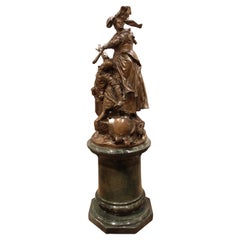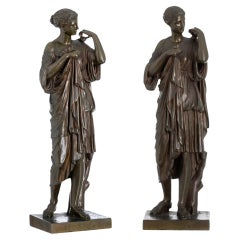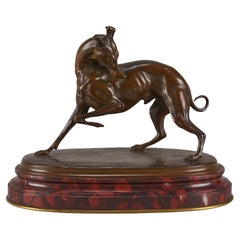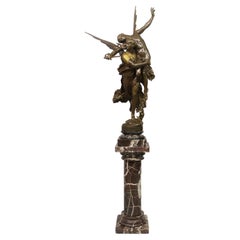Antonin Mercie Busts
to
1
1
1
1
1
1
1
Height
to
Width
to
1
1
1
2
120
47
38
25
Creator: Antonin Mercie
Exceptional 19th Century Bronze Entitled ““Quand Meme” by Mercié and Barbedienne
By Antonin Mercie, Ferdinand Barbedienne
Located in Long Island City, NY
A Large and Exceptional Late 19th Century Patinated Bronze Figural Group Entitled “Quand Meme” by Mercié and Barbedienne on Pedestal
Marius-Jean-Antonin Me...
Category
Late 19th Century French Belle Époque Antique Antonin Mercie Busts
Materials
Bronze
Related Items
Ferdinand Barbedienne " Diana" Sculpture, 19th Century
By Ferdinand Barbedienne
Located in Madrid, ES
"Diane de Gabies"
French sculpture, late 19th century.
Patinated bronze with "Ferdinand Barbedienne" foundry marks.
Height: 51 cm.
Very goo...
Category
19th Century French Baroque Antique Antonin Mercie Busts
Materials
Bronze
Late 19th Century Animalier Bronze entitled "Turning Whippet" by L Mayer
By Louis Mayer
Located in London, GB
Delightful late 19th Century French Animaliers bronze study of a turning whippet looking around in an attitude to play, with rich brown colour and fine hand chased surface detail. Si...
Category
Late 19th Century French Art Nouveau Antique Antonin Mercie Busts
Materials
Marble, Bronze
$3,465
H 6.7 in W 8.67 in D 6.7 in
19th Century F. Barbedienne Bronze Champlevé Enamel Candlesticks
By Ferdinand Barbedienne
Located in Stockholm, SE
A fine pair of champlevé enamel candlesticks in a chinoiserie style by Ferdinand Barbedienne (1810 - 1892), made in Paris ca.1880. Signed "F. Barbedienne"
They are an example of the ...
Category
1880s French Chinoiserie Antique Antonin Mercie Busts
Materials
Bronze, Enamel
Sculpture in Patinated Bronze by Ferdinand Barbedienne, 19th Century.
By Ferdinand Barbedienne
Located in Saint-Ouen, FR
Sculpture in patinated bronze by Ferdinand Barbedienne, 19th century, Napoleon III period.
A 19th century patinated bronze sculpture, Napoleon I...
Category
19th Century French Napoleon III Antique Antonin Mercie Busts
Materials
Bronze
$9,709
H 19.1 in W 11.42 in D 10.24 in
French 19th C Gilt and Patinated Bronze Group of Gloria Victis, by A. Mercie
By Antonin Mercie, F. Barbedienne Foundry
Located in New York, NY
An Incredible and Large Gilt and Patinated Bronze Group of Gloria Victis, a Winged Figure of Victory with a Fallen Warrior. This incredible bronze piece was cast after a model by Maarius-Jean-Antonin Mercié, This model is signed 'F. BARBEDIENNE FONDEUR PARIS' demonstrating that it was cast by Ferdinand Barbedienne's foundry, the best bronzier of the 19th century. The base is further signed 'A. Mercie' and stamped 'Réduction Mécanique' with an inscription of '659'. The figure is mounted on a Belgian noir marble base with various stepped edges. Gloria Victis is one the most well-known and important bronze casts of the 19th Century. The quality of this particular model is absolutely incredible and all the marking indicate that this particular piece is one of the finest produced by the Foundry.
A student of Jouffroy and de Falguière at the Ecole des Beaux-Arts, Marius-Jean-Antonin Mercié (1845-1916) won the Grand Prix de Rome at 23 years old with his work Thésée vainqueur du Minotaure. In 1872, he sent the plaster model of his work David vainqueur to the Salon, for which he won the first class medal. At the same time, he received La croix de la Légion d'honneur at the Villa Medici. His return to Paris, in 1874, issued in a long and brilliant career with numerous commissions, notably the monuments for Louis-Philippe and Queen Marie-Amélie for the Royal Chapel at Dreux (1886).
By the age of 30 Mercié was already very well-known and his Gloria Victis received resounding success when it was exhibited at the Salon, in 1874 (in plaster) and in 1875 (in bronze). This work exalted the heroism and the patriotic sentiments aroused by the disasters of 1870. His predilection for patriotic subjects is shown in many of his works such as Quand même...
Category
19th Century French Louis XVI Antique Antonin Mercie Busts
Materials
Belgian Black Marble, Bronze
$29,726
H 31.5 in W 9.5 in D 8 in
Italian 19th Century Bronze Statue of Apollo, Signed F. Barbedienne Fondeur
By Ferdinand Barbedienne
Located in West Palm Beach, FL
A handsome and high-quality Italian 19th century patinated bronze statue of Apollo, signed F. Barbedienne, Fondeur. The statue is raised by a circular base with a finely detailed tre...
Category
19th Century Italian Antique Antonin Mercie Busts
Materials
Bronze
$26,500
H 35.75 in W 22.25 in D 15.25 in
Antique Gilt Bronze Mantel Clock by Sevin and Barbedienne
By Ferdinand Barbedienne, Louis-Constant Sevin
Located in London, GB
This ormolu clock is an exemplary work by the famous French 19th century metalworker and foundry-owner, Ferdiand Barbedienne. Working with a design made by the acclaimed onamentalist, Louis-Constant...
Category
Late 19th Century French Neoclassical Antique Antonin Mercie Busts
Materials
Ormolu, Bronze
19th Century Decorated Bronze Vase Signed by F. Barbedienne
By Ferdinand Barbedienne
Located in Sofia, BG
Bronze vase of balustrades forms a relief of a musical and a shepherdess in an entourage of foliage and birds, resting on a pedestal area of a lezard and a surouris standing over red...
Category
Mid-19th Century French Antique Antonin Mercie Busts
Materials
Bronze
$2,998 Sale Price
40% Off
H 11.03 in Dm 3.15 in
19th Century Gloria Victis bronze statue, By Barbedienne.
By F. Barbedienne Foundry, J.A. Mercie 1
Located in Brighton, Sussex
A very impressive 19th Century patinated bronze statue of 'Gloria Victis' with gilded highlights. Raised on a marble plinth.
Signed; A MERCIE
Stamped; F. BARBEDIENNE
Gloria Victis wa...
Category
19th Century French Antique Antonin Mercie Busts
Materials
Marble, Bronze
French 19th Century Patinated Bronze Statue Signed P. Dubois And F. Barbedienne
By Ferdinand Barbedienne
Located in West Palm Beach, FL
An exceptional French 19th century patinated bronze statue signed P. Dubois and F. Barbedienne. The statue entitled Le Courage Militaire, is raise...
Category
19th Century French Antique Antonin Mercie Busts
Materials
Bronze
$28,500
H 34 in W 14 in D 16 in
19th Century Silvered Bronze Athénienne Jardinière by Ferdinand Barbedienne
By Ferdinand Barbedienne
Located in Oxfordshire, United Kingdom
A French silvered-bronze athénienne by Ferdinand Barbedienne, Paris, last quarter 19th century with a revolving liner, the frieze applied with bucrania suspending ribbon-tied berried laurel swags above a border of bellflowers on a stippled ground above three seated female sphinxes issuing stylised foliage and scrolls on lion monopodia cast with the mask of Hercules, scrolling foliage and anthemions joined by stretchers, raised on a concave-sided triform marble base on a further thin silvered-bronze base, inscribed to the tripod base 'F. BARBEDIENNE'
Measures: 103.3cm. high, 41.5cm. diameter; 3ft. 4 3/8 in, 1ft. 4 1/4.
This impressive athénienne is a key reminder of the longevity of a particular model and design’s success from Antiquity through to the 19th century and up until this day. Typically known as the ‘Trépied du Temple d’Isis’, this athénienne is designed after the Roman antique originally found at Pompeii and now at the Museo Archeologico Nazionale, Naples (fig.1). From being for example an inspiration for the baptismal font of Napoléon’s son in 1811, this model was the inspiration to many highly skilled makers throughout the 19thcentury such as the Manfredini brothers from Milan and of course the Parisian well-established bronze founder Ferdinand Barbedienne who executed the present example.
The Temple of Isis was a Roman temple dedicated to the Egyptian goddess Isis and was among one of the first discoveries during the excavation of Pompeii in 1764. Certainly considered as one of the most elegant examples of antique tripods, the existence of this model was then popularized to the rest of Europe via prints, one of the first being by Giovanni Battista Piranesi in 1779. This type of tripod was also popularised by an engraving in C. Percier and P. Fontaine’s, Receuil de Décorations Intérieures of 1801. Interestingly, there is also a watercolour now in the Musée Carnavalet, Paris, showing this type of tripod displayed at the 1801 Exposition des Produits de L’Industrie in the Louvre.
The passion for Greek and Roman Art in the 19th century.
The discovery of Pompeii and Herculaneum around the middle of the 18th century gave rise to a new passion for Antiquity and the excavated masterpieces renewed the repertoire of fine and decorative arts and served as models for Neoclassicism. Members of the aristocracy as well as connoisseurs, particularly in England, completed their education by undertaking a ‘Grand Tour’ of Italy and often fell victim to the recently unearthed Greek and Roman artefacts...
Category
19th Century French Grand Tour Antique Antonin Mercie Busts
Materials
Marble, Silver Plate, Bronze
$67,319
H 40.56 in Dm 16.34 in
Ferdinand Barbedienne Bronze Boy & Goose Sculpture 19th Century
By Ferdinand Barbedienne
Located in Bishop's Stortford, Hertfordshire
A finely patinated French antique bronze by Ferdinand Barbedienne portraying a a young boy caressing a large goose. The figure is mounted on an a...
Category
19th Century French Napoleon III Antique Antonin Mercie Busts
Materials
Bronze
Previously Available Items
Exceptional Late 19th Century Bronze “Gloria Victis” by Mercié and Barbedienne
By Antonin Mercie
Located in Long Island City, NY
The wonderful and exceptional Late 19th Century bronze figural sculpture entitled “Gloria Victis” by Mercié and Barbedienne
Antonin Mercié and Ferdinand Barbedienne
Bronze, mid-brown patina with gilt highlights, raised on a Levanto Rouge marble revolving pedestal.
Signed A. Mercié and inscribed F Barbedienne Fondeur Paris to the base.
The Gloria Victis sculpture...
Category
19th Century French Belle Époque Antique Antonin Mercie Busts
Materials
Marble, Bronze
H 56 in W 33 in D 25 in
Antonin Mercie busts for sale on 1stDibs.
Antonin Mercie busts are available for sale on 1stDibs. These distinctive items are frequently made of metal and are designed with extraordinary care. There are many options to choose from in our collection of Antonin Mercie busts, although gold editions of this piece are particularly popular. If you’re looking for additional options, many customers also consider busts by F. Barbedienne Foundry, and Ferdinand Barbedienne. Prices for Antonin Mercie busts can differ depending upon size, time period and other attributes — on 1stDibs, these items begin at $5,707 and can go as high as $65,000, while a piece like these, on average, fetch $35,354.



